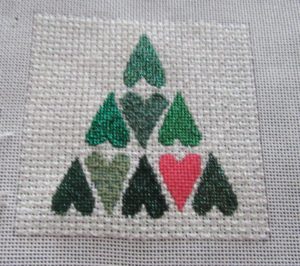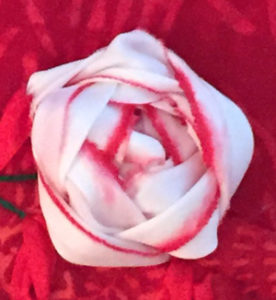
Please note: For the next two weeks, we’ll be having a little Thread Festival. You’ll find new & updated reviews of threads, articles about finding unusual threads & about ways to expand your choice of stitching threads. Welcome in summer with this little festival!
Planet Earth Fibers makes, in addition to their lovely silk and wool threads, silk ribbons. They come in several widths and in two types of colors. Along with the solid colors, there are also colors that have edges in a different color.

These edged ribbons make simply wonderful flowers, allowing you to get a second color, even one that is quite different, at the edge of the flower. This ribbon rose, from their blog, shows you just how lovely this effect can be.
I like to use narrow silk ribbons for Tent Stitch because the crinkled effect of the ribbons in this small stitch is an interesting test. It is also a great way to see how this different effect might change the color.
I took two ribbons and stitched the two lightest hearts with them. The base color was nearly the same for both. The heart in the middle used the ribbon with the extra edge color. The heart in the bottom row used the solid ribbon.
There is clearly a difference in color on the edge-dyed ribbon, an effect similar to needleblending. This happens because sometimes one color is on top of the canvas for a stitch. Sometimes the other color is on top. Sometimes both colors show. The effect is that you get a color between the two shades. If you look closely at the heart, you can see this.
Although this is commonly done with strands of two or more colors used in the same needle, to get the same effect in a single strand is unique. It happens because the different color on the edge behaves as if it were a second strand when stitched.
What surprised me is that there is a similar, but smaller, effect with the solid ribbon. In this color at least, the edges are not the exact same color, as one might expect, but a different color. On the edge-dyed ribbons the new color goes down into the ribbon. On the solid ribbon the color is confined only to the selvedge.
Because the different color is only at the edge, it shows up much less often in the stitching. If you look closely, however, you will see it. This gives even solid colors some depth and richness. In more typical stitches for ribbon, it will make each stitch distinct.
While I really liked the effect of the colors, I did not much like stitching Tent with them. 4mm ribbons are just a bit too wide for 18 mesh and the stiffness of the ribbon, especially the selvedges, can make a huge difference. The edges here are thicker than most and a bit stiff. This makes it harder for it to squeeze into the canvas holes.
I liked this ribbon and I especially liked the interesting color effect you can achieve with it. I would limit my use to ribbon stitches where its colors work to your advantage and to Tent and textured stitches on larger mesh. Because the edges are different colors, I would not use them for covering padding or stumpwork. In these techniques you want a smooth finish, almost like fabric. The color changes would prevent this.
About Janet M Perry
Janet Perry is the Internet's leading authority on needlepoint. She designs, teaches and writes, getting raves from her fans for her innovative techniques, extensive knowledge and generous teaching style. A leading writer of stitch guides, she blogs here and lives on an island in the northeast corner of the SF Bay with her family

Leave a Reply